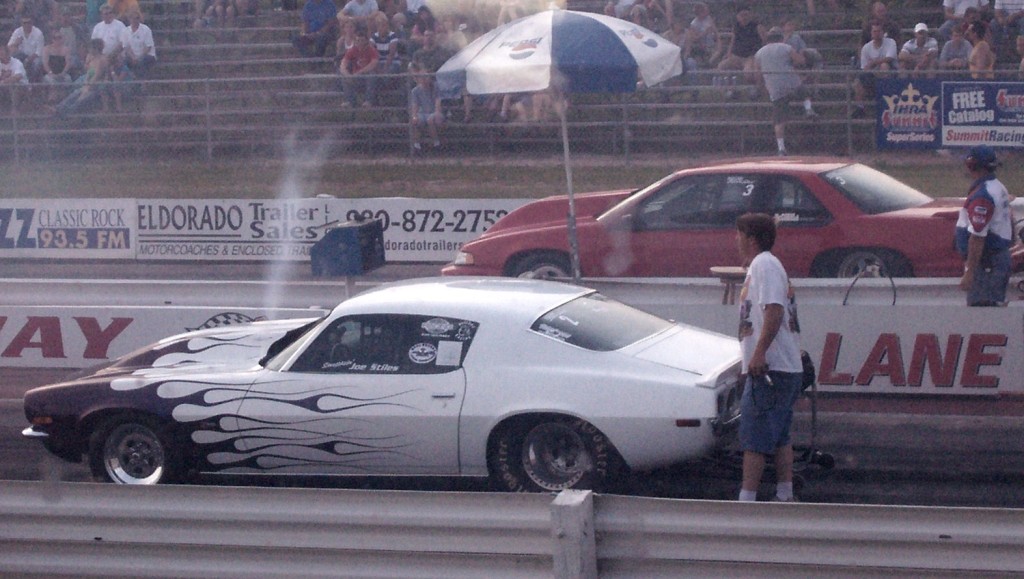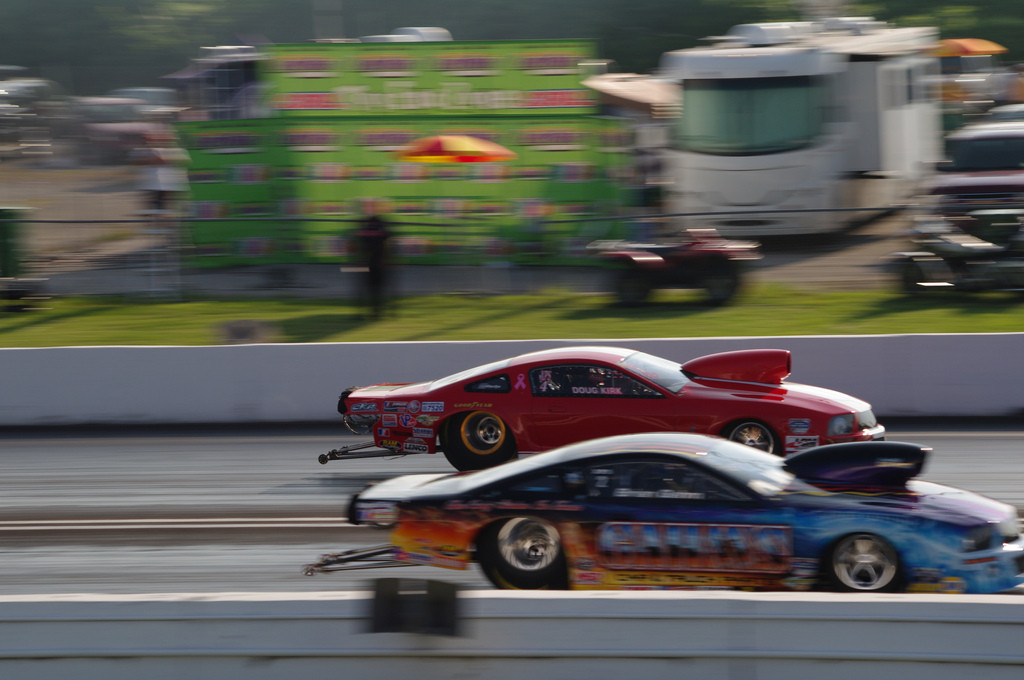

Drag Race 101: Your Gas Can Make All the Difference
Racers have numerous choices when it comes to the fuel they use on race day. What race fuel you choose will depend on a variety of factors including: the requirements of the engine, the class you’re entered in, the rules of the sanctioning body overseeing the race (if any), the conditions on race day, and the rules of the track. Let’s take a look at what’s out there and where and how these fuels are best used.
Let’s Get Technical with Gasoline for a Minute
Whether we have a street car or a full-on dragster, we want the air and fuel in the chamber to burn at an equal rate and to burn completely. We also don’t want knocking and pinging. The octane rating of a fuel can be adjusted to accomplish both knock/ping elimination and complete fuel burn while the rate of burn throughout the combustion chamber is slow enough to ensure full fuel burn off. As you increase the compression ratio of the engine, you need to increase the octane of the fuel you use. This is why we have three options to fill up with at the corner gas station.
Regular Old Pump Gas
“Regular old pump gas” is something of a misnomer. I grew up at a gas/service station during the 70s and 80s and the blends went from fairly vanilla to pretty wild just in that time frame. To this day it’s still evolving. Most “daily drivers” can get by with mid-grade pump gas. Those that are either turbo- or supercharged should use the premium blends with higher octane. This stuff ranges from 87 to 93 octane.
There’s also a company that sells a fourth grade of gasoline which they claim has a minimum of 100 octane versus the 92-93 of premium pump blend gasoline. When I was an active participant in the sport there was also a company that sold what they called “Trick Racing Gas” that claimed to have a 120 octane rating.

Aviation Fuel
Yes, I said aviation fuel. I’ve added about an eighth of a tank of civil aviation-grade fuel to every fill up to my high performance street cars. The performance boost it gives is more than noticeable. On race day with a street legal vehicle, I fill up as usual but use a little more avgas and fill two or three five gallon gas cans for at the race. Before each pass, I top up to the minimum allowed fuel level with the avgas from the cans.
The octane of avgas is a minimum of 120. This allows/causes it to burn more slowly and smoothly in the chamber and eliminates the knock and ping that can quickly destroy an engine. It’s excellent for those engines that run higher boost at tracks or events where other, some would call better racing fuels, are not allowed. Then again, some tracks ban avgas, too.
Nitromethane
Nitromethane is what is used in full-on dragsters and funny cars. It is arguably one of the best racing fuels on the market for that class of car. Nitromethane has a significantly lower energy density than gasoline. However, the fact that only 1.7 kilograms of oxygen is needed to burn one Kg of nitromethane while 14.7 Kg of O2 are needed to burn a single kilo of gasoline means that our engines can burn almost nine times as much nitromethane and net more than twice the power in the process.
This race fuel also has what is known as a high latent heat of vaporization. This means that is has to absorb large quantities of engine heat before it vaporizes. What this means for us is that it helps cool the engine quite a bit.
It’s also the most dangerous. Since its introduction a few decades ago, it’s been the main culprit in many a fantastic and tremendous blower explosion. It’s also been the cause of some pretty nasty pit accidents when people were careless with it.

Nitromethane in racing is always blended with something else. The National Hot Rod Association (NHRA) mandates a maximum content of 90 percent nitromethane mixed with a minimum ten percent methanol. Engines running this fuel produce massive amounts of horsepower because they are run extremely rich.
Due to the fairly slow burn rate of nitromethane, the fact that these engines run so rich doesn’t allow the fuel to burn completely, exhausting fuel that is still burning and raw fuel that ignites on contact with the oxygen in the air, causing the big flames we see coming from the headers.
Racing Blends
Racing blends are racing fuels that come from gas companies that usually specialize in nothing more than racing fuels. Although they can be used in daily drivers, they are chemically-enhanced to increase power and torque output and give us faster passes. I can’t even dream of mentioning every company that produces a racing fuel for the drag racing community, but I can touch on the larger and more well-known ones.
Sunoco is probably the most well-known producer of racing fuels due to its involvement with sanctioning bodies. Sunoco produces a blend it calls Sunoco Maximal which is a 116 octane blend of leaded racing fuel that is designed for high compression engines. If you’re using a blower or turbo, you probably don’t want this one unless it’s all that’s available.
VP Racing makes a few different racing fuel blends. One is what they call X16™ which is a 116 octane blend designed for engines with up to 16:1 compression, using nitrous, and making up to 300 HP. They also have VP-110™, a 110 octane blend for engines making up to 13:1 compression. They also have C12, which they advertise as one of the winningest fuels in racing history. This is for engines with compression ratios below 15:1.
Torco Racing Fuels is another company with a good history of making quality racing fuels for drag racers. Torco 116 is blended to be ideal for smaller engines with lots of boost or big engines with mild boost. Torco 118 is blended for larger engines, 500 cubes and up, with higher compression ratios, 15:1 and up. Torco also produces a nitromethane blend and a methanol blend.
Dragon Racing Fuels is a newer company with four different racing fuel series and a racing fuel concentrate. The Legend, Tarragon, and Tarragon O2 series are blends with octane ratings ranging from about 100 to over 120. The racing fuel concentrate is an octane booster that boosts pump fuel up to about 102 octane.
Whichever fuel is best for your ride, make sure you follow ALL of the safety precautions designated by the manufacturer and by your track/race series.
Got thoughts to share on your experiences with race gas for your strip burner? Reply here, email us at [email protected] or visit us on Facebook!


I didn’t know TORCO was still in business.
If I am running a stock Z06 but wont be long how high can I go and still remain safe to my engine but get a significant increase, enough for the trouble. I plan on upgrading my cam, exhaust and probably running a single stage No2 nothing extreme maybe a 250 burst but havent decided. I would like to know fuel recommendation then as well as if anyone can give recommendation on how to get bang for bust and this will be street driven as well but not daily driver.
If you run nitrous, call the company that makes the kit; they will advise you on minimum octane with your compression at about 10.7 to 1(?), and timing, which BOTH are REALLY important. And just my opinion, a 250h.p. “burst” is VERY extreme for an aluminum block and heads. Better get the ECU re-flashed for a LOT LESS TIMING when using the nitrous.
I am not running Nox now C6 Z06 with K&N intake only.
Is there a fuel or additive or mixture that would give noticeable increase without chance of damaging motor.
I have heard this engine has rather thin cylinder walls and as much as I would love to stab an LSX in I just can’t put that much into it. Any recommendation to get best bang for buck and any shops in or near Austin TX.